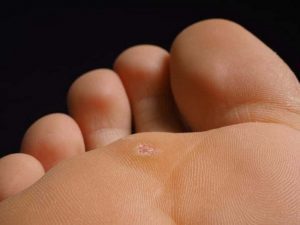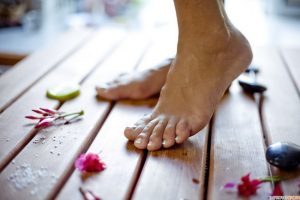Plantar warts are a viral skin growth, also called corn. Medical terminology shows that these formations are located on the soles of the feet and toes. They are not dangerous for oncological risk, but they cause a lot of discomfort while walking due to their painful compression.
Causes of Herbal Warts
All types of warts, including plantation warts, are caused by the human papillomavirus (HPV). You can get it in close contact with infected people or in your daily life. The virus dies quickly from sunlight, but feels good in high humidity. Therefore, HPV infection most often occurs in baths, saunas, swimming pools. Penetration of the virus is facilitated by microtrauma and skin cracks, as well as decreased immunity.

With the body's strong protective properties, the virus can remain dormant indefinitely after infection. But as immunity declines, it begins to multiply actively, provoking the appearance of warts of various localizations on the skin. HPV subtypes 1, 2, 4, 27, and 57 alone are responsible for most of their occurrence.
Several predisposing factors contribute to the appearance of such formations:
- shoes that are too tight or too large;
- frequent wearing of high heels;
- various foot deformities (including flat feet);
- various diseases of the joints of the legs (arthritis, arthritis, etc. ).
Heart hearts are more common in people with excessive dry skin and hyperkeratosis.
Thus, the causes of planar warts are the same in all cases (HPV infection), but the predisposing factors are different. The number and size of the elements on the skin depends on them and the state of immunity.
How Plantatal Warts Appear
The wart on your leg looks like a rounded skin growth. They can vary in size, but are rarely more than two centimeters in diameter. It rises up to three millimeters above the level of the skin, yet goes deep into it with its root. The color should not deviate from the surrounding skin and may be darker or lighter. Such formations are often yellow or gray in hue. Visually, when viewed inside the elements, black dots or lines are visible (they are also clearly visible in the image). This is what capillaries look like, in which blood clots form due to the massive compression of horny blood vessels.
First, the plantar wart has a smooth surface. But over time, it will be hard, rough, thickened. The horny masses give these warts their yellow color.
An important symptom of warts is compressed pain. Each step causes severe acute pain in the patient.
These warts are very similar to planar calli. The resemblance to cornice is particularly pronounced due to the severe pain in both formations. The main difference is that there is no skin pattern on the surface of the wart, while it remains in the dermatitis.
Diagnosing plant warts
The competent dermatologist will only diagnose this disease based on a clinical picture. In some cases, additional dermatoscopy is required. This diagnosis is confirmed by the lack of skin pattern associated with the formation and blood clots in the blood vessels.
Treatment of herbal warts

Plant warts are harder to get rid of than similar formations in other areas because they penetrate deeper into the dermis. In the case of small and newly formed elements, necrotizing external preparations can be used. Large and deep warts are surgically removed. However, old formations must first be softened with keratolytic agents.
External wart removal preparations
In some cases, self-destruction of such formations is possible. However, because the wart hurts the eyes quite a lot, patients do not want to wait and try to get rid of them as soon as possible.
Any plant wart with a necrotizing effect is needed to remove small and superficial elements.
These products contain acids that coagulate skin proteins and cause necrosis. Refrigerant-containing drugs have a similar effect. But they cause a necrotizing effect by freezing the tissues, not by chemical damage.
All of these drugs are used sharply to form. It should be strictly checked that the material does not fall on the surrounding tissues as this will burn them. After treatment, a wound remains at the site of the previous wart, which is covered with bark. After healing, it falls on its own. You can do this treatment at home, but only as directed by your doctor.
In this way, only small and shallow plantar warts on the skin can be removed. For large items, you must choose other removal methods, as incomplete destruction of the wart tissue will in any case lead to recurrence.
Surgical methods to remove plant warts

There are different ways to remove a wart during surgery. Gentle methods are preferred:
- laser removal;
- radio wave knife;
- cryodestruction;
- electrical automation.
All of these procedures are performed on an outpatient basis. Patients literally go home a few minutes after they are finished, all they have to do is start treatment for the wound at home on a regular basis.
The most effective and safest methods of removing plant warts are laser or radio excision. When performed, the blood vessels coagulate immediately, which is good for preventing bleeding and secondary infection. Complications associated with the removal of skin formations by such methods are extremely rare. The same cannot be said for cryodestruction and electrocoagulation, so these treatments have fallen into the background and are rarely used.
If the warts are large or old (covered with a large amount of horny mass), it is recommended to treat them with keratolytic agents for two weeks before the removal procedure. For this purpose, salicylic ointment or acid and other drugs are prescribed. Thus, it is possible to displace some of the deer scales to make the formations softer and more flexible. This makes wart removal easier and faster.
In rare cases where there are many elements or doubts about their nature, the doctor is advised to perform surgical excision with a scalpel. With this method of wart removal, the rehabilitation period and the risk of scarring are much longer, so it is only used for strict indications.
Characteristics of plantar warts in children
Plantation warts are very common in children under the age of five because they often run barefoot, are injured, and do not always follow the rules of personal hygiene. Impairment of immunity due to regular contact with patients (in kindergartens and schools), which increases the likelihood of warts.
Treatment of such formations in children is best started with external agents. You can try to clean the shallow elements with salicylic ointment, this is followed by the pimpa. Immunomodulatory drugs have proven well. By placing it on a regular wart, it can be removed within a few weeks.
If the batteries are deep, use necrotizing agents or remove them with a laser or radio knife.
Prevention of herbal warts

It is completely impossible to protect yourself from the occurrence of warts, but you can reduce the risk of their occurrence. To do this, you need to go in two directions: eliminating predisposing factors and stimulating the body's defenses.
To reach the first goal, you need
- follow personal hygiene rules (do not walk barefoot in public places, wash your feet daily and treat cuts and injuries in a timely manner);
- choose comfortable shoes by size;
- in time to prevent foot deformities and treat joint disease
A healthy lifestyle, exercise, exercise, taking vitamin complexes, and immunostimulatory medications as prescribed by your doctor will help your body maintain a good level of defenses.
Regular medical pedicures and exfoliation are recommended for excessively dry skin and hyperkeratosis. In case of excessive sweating of the legs, special agents should be used to treat hyperhidrosis. By following these rules, there is minimal risk of developing warts on the soles of the feet
Warts are not a dangerous disease, but they cause a lot of discomfort due to pain during walking. Fortunately, in modern medicine, there are many ways to get rid of it quickly and with minimal risk of new relapses. To do this, you should consult a dermatologist and strictly follow all your appointments and recommendations.















































































